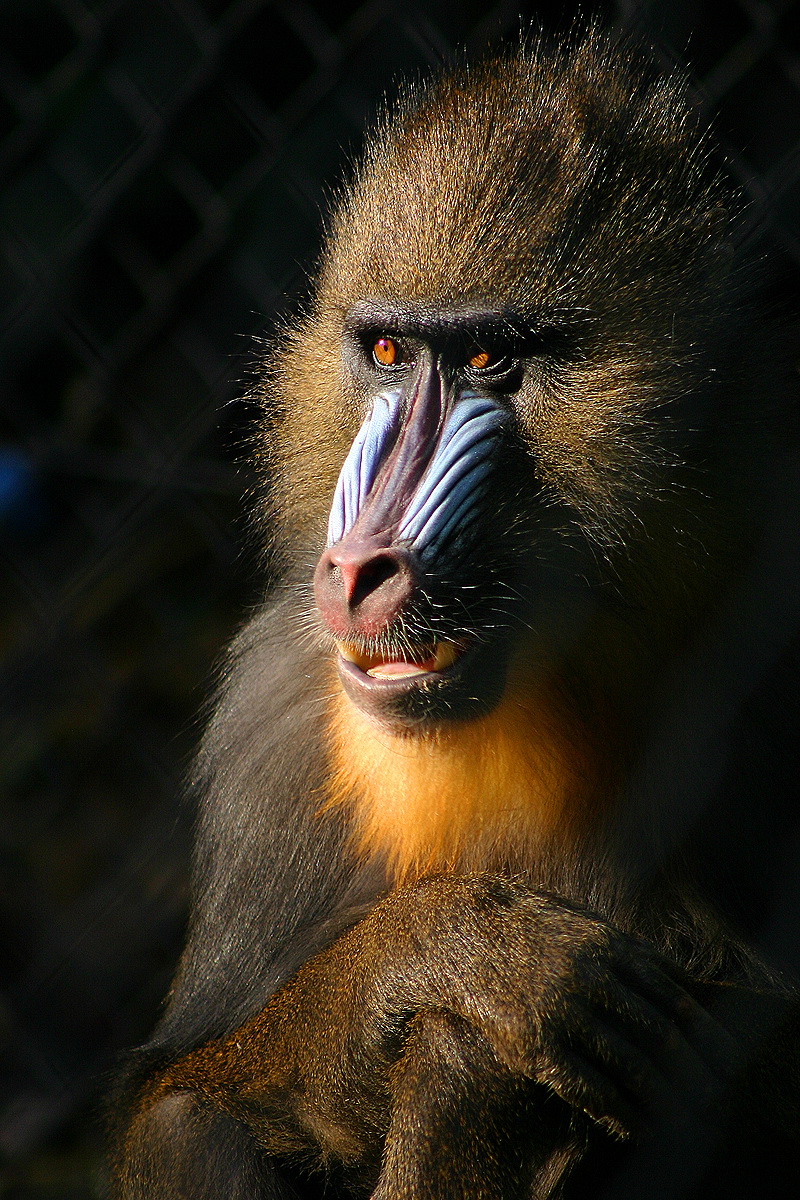| New Photos | Animal News | Animal Sounds | Animal Movies | Upload Photo | Copyright | Korean |
|---|
| Funny Animal Photos | Monsters in Animalia | Wiki Articles Fun Facts about Animals | Links | Home | Mobile A.P.A. |
|---|
| Image Info | Original File Name: Mandril-Mandrill (Mandrillus sphinx).jpg Resolution: 800x1200 File Size: 491358 Bytes Date: 2005:11:08 12:08:10 Camera: Canon EOS DIGITAL REBEL (Canon) F number: f/5.6 Exposure: 1/250 sec Focal Length: 290/1 Upload Time: 2007:10:06 19:04:33 | |
| Author | Name (E-mail): Unknown | |
| Subject | Mandrill (Mandrillus sphinx) - Wiki | |
 |
| Email : E-Card | Poster | Web Master Delete Edit Info Admin |
| Description | Mandrill (Mandrillus sphinx) - Wiki
Mandrill
The Mandrill (Mandrillus sphinx) is a primate of the Cercopithecidae (Old-world monkeys) family, closely related to the baboons and even more closely to the Drill. Both the Mandrill and the Drill were once classified as baboons in genus Papio, but recent research has determined that they should be separated into their own genus, Mandrillus. The Mandrill is the world's largest species of monkey. The word mandrill means "man-ape". Description The Mandrill is recognized by its olive-colored fur and the colorful face and rump of males, a coloration that grows stronger with sexual maturity; females have duller colors. This coloration becomes more pronounced as the monkey becomes excited and is likely to be an example of sexual selection. The coloration on the rump is thought to enhance visibility in the thick vegetation of the rainforest and aids in group movement. Males can weigh up to 60 lb (30 kg), females about half as much. They can grow to be about 1 m long (39 in) and can survive up to 25 years in captivity. Females reach sexual maturity at about 3.5 years. Habitat The Mandrill is found in the tropical rainforests of southern Cameroon, Gabon, Equatorial Guinea and Congo. Its distribution is bounded by the Sanaga River to the north and the Ogoou?? and Ivindo rivers to the east. Recent research suggests that mandrill populations north and south of the Ogoou?? river are genetically so different as to be different sub-species. Behavior Mandrills are social creatures and live in large groups, primarily including females and young and led by a single dominant male. Most adult males are solitary. It is difficult to accurately estimate group size in the forest, but filming a group crossing a gap between two forest patches or crossing a road is a reliable way of estimating group size. The largest group verifiably observed in this way contained over 1300 individuals, in Lop?? National Park, Gabon - the largest aggregation of non-human primates ever recorded. The Mandrill is an omnivore and acquires its food by foraging (mainly plants, insects and smaller animals) from the ground as it is terrestrial. Its main natural predators are leopards. A large group of mandrills can cause significant damage to crops in a very short time, and where common they are widely perceived as pests. Mandrills are hunted for food throughout their range, either with guns or using dogs and nets. In Cameroon, habitat loss to agriculture is also a threat. Although the Mandrill does not normally hunt larger prey, males have been observed to hunt and consume duiker (a small antelope). Reproduction The gestation (pregnancy) time for the Mandrill is 6???7 months and young are usually born between January and April. However, the mandrill mates throughout the year during the estrus cycle, which occurs once every 33 days. The interbirth interval is typically 13-14 months. Courtship During courtship, the male will walk after the female as the female leads. The male will then make little courtship noises, baring his teeth and vocalizing softly. If the female likes what she hears she will orientate her rear towards the male. The male will mount her and they commence copulating. After copulation, the female will depart. Parenting Mandrill infants are born with their eyes open and with fur. They have a black coat and pink skin for the first two months. They cling to their mother's belly immediately and can support their own weight. Mothers form bonds with their children. These bonds last into adulthood with the daughters, while the bonds with the sons last only until his sexual maturity. These bonds entail the two sitting with each other and grooming each other. http://en.wikipedia.org/wiki/Mandrill
| |||
| Copyright Info | AnimmalPicturesArchive.com does not have the copyright for this image. This photograph or artwork is copyright by the photographer or the original artist. If you are to use this photograph, please contact the copyright owner or the poster. |
|
|
|
| |||||||
| CopyLeft © since 1995, Animal Pictures Archive. All rights may be reserved. | ||||||||
Stats